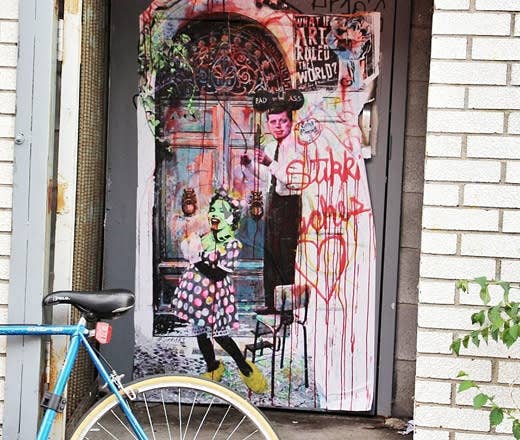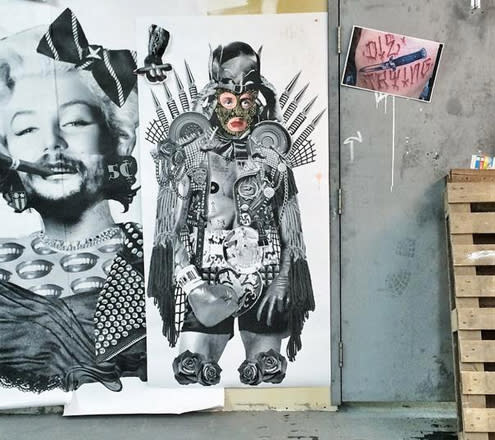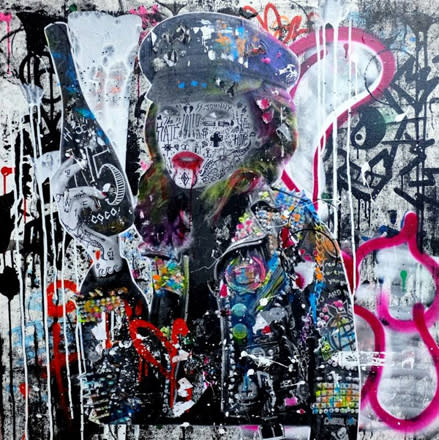
Stikki Peaches, a Montreal based street artist, has been rolling out his revolution of Art, "What if Art Ruled the World?" since 2009. Taking his revolution to the streets through art, his message has been spreading across cities around the world from Montreal to Paris, London, Berlin and Stockholm. Although Stikki’s process is fairly common these days among street artists, wheat pasting, his unique approach to mashing up high culture and low culture reveals an underlying mantra of disrupting the mainstream discourse with irony and satire. This isn’t just another attempt of using the master’s tools to disrupt the master’s ideologies; rather it is about mash up or play and his childhood nostalgia for superheroes. Who else could help save the world through art than Batman or James Bond?
Complex: Why did you pick the tag line - What if Art Ruled the World?
Stikki Peaches: It was a question I asked myself during a time when things seemed complicated in my life. It was a time when a lot of uncertainties took up most of my thoughts. Creating art was my escape; it took me away from any negative feelings and directed that energy towards something positive. My work became my healing process. I know the power of art and creativity and how much it means to me to be able to do this every day. I ask the question to create a global dialog. I’m always interested in people’s answers. Some might think it's absurd to think that art rules the world, some think it already does, some don't care for the arts at all… it’s all in what you believe, where you've been, and where you're headed.
C: What do you consider the difference between graffiti and street art?
SP: In terms of techniques, graffiti has always been as raw as it gets. For the longest time, it was seen as a black eye in cityscapes across the world, but some of the best and most talented artists today stem from their graffiti roots. On the other hand, street art has been considered the annoying little brother of the graffiti scene and often looked down upon, but at the same time, some of today's biggest names in the art world come from the street art scene as well. Today, I'm not sure there is much of a difference. Both seem to be socially accepted more and more, with art fairs and mural festivals all over the world offering platforms for both graffiti and street artists alike, and sometimes even working together. Times have changed.
1.

C: Your earlier worked seemed to images from mash ups of superheroes and now you have turned to other pop culture icons? Do you see this as a change in direction or more of the same? How So?
SP: I try to mix things up when creating new bodies of work, but the core of my inspiration and influences have always been super hero based. A lot of the characters I use are from childhood memories of watching cartoons, movies or TV shows from the 80's and 90's. Come to think of it, most of these cartoons and shows wouldn't even be aired today because of their content! The world has changed in every way: from religion, to politics, to race and culture. In my art, I go back to those simpler times, adding a pop culture twist every now and then. It takes me away from all that is negative.
C: Can you describe a bit about your process as it is different that typical wheat-pasting - much more detail and nuance. How do you get inspiration and then go about creating the piece.
SP: It's the little details that sometimes take you to the next level. I've always been obsessed with details and the things someone else might not notice at first glance. Slight differences that make a piece that much more important or enjoyable to look at and discover. Striking a cord with the viewer by simply placing something in the right spot. Sometimes it’s a happy mistake that finds it’s place and seems meant to be. I want to engage the viewer or have them sit back and enjoy all that is going on. I'm a collector of things: I love anything vintage, magazines, comics, signage, figures, clothes, etc. I like to spend my days thrift shopping, or visiting antique shops. I add element to my work that I’ve picked up from travels and discoveries. Some items are from my personal collections, which are harder to get rid of… I enjoy adding those personal touches.
2.

C: Your work always seems to have a hint of irony, irony is never without a politic, what is your aim with employing irony?
SP: My use of irony and political undertone always takes a satirical stance. I do it through iconic pop culture figures or images.
C: I must admit that I am a huge fan of your newer work with Kate Moss - why Kate?
SP: Thank You. Kate Moss has always been iconic, whether in the fashion world or in her personal life. She's been through many ups and downs throughout her career, all of which was very well documented. But in those ups and downs, she has never floundered or missed a beat. She shaped the modeling world and made it her very own. She’s beautiful, powerful, raw: a true fucking rock star doing her thing and doing it like no other. While many want to be like her, there's only one Kate. I feel she's become the new Marilyn Monroe. You still see loads of Marilyn inspired art, but are starting to see a lot of Kate Moss tributes as well. I have my own twist, look and feel when working her pieces, and truly enjoy creating different “forms of Kate.” I hope I do her justice.
3.

C: How do you think being a Montrealer influences you work?
SP: Being a Montrealer, born and raised in a city that’s multicultural with language wars always on the forefront, this gives me different platforms to work with. Alternating works from English to French, or visiting certain parts of town that have that European flare also influences my work. Most of my work is pre planned before I hit the streets. I’m inspired by the architecture and ethnicity of a particular area and try to make sure the piece fits the right “frame.”
C: You have chosen to remain fairly anonymous as an artists, in the same vein as Banksy (as opposed to someone like Shepard Fairey), is this simply for legalities or was it a conscious decision to keep the mystery in the 'brand'?
SP: I want to be able to detach my art life from my personal life. I love my personal space, and being able to move around freely, dealing with people in a normal every day setting is important to me. It’s not to say that I don't and won't meet with people when and where my work is concerned, I'm just very selective when it comes to who I’m in contact with “as Stikki.” It's worked for me since day one, why fix something thats not broken?
4.

C: How has social media changed the ways in which you do art? Is it an advantage or disadvantage?
SP: I'm not sure social media changed the way I make art. I've been active on these social media platforms from the very beginning; I've seen its advantages or disadvantages. My progression and evolution are something I work hard at every day, with and without social media. I know what works for me and I know what doesn't. From there, I build.
C: You have branded your message and art on walls in Montreal, Paris and New York. Where will you spread your What if Art Ruled the World message next?
SP: Spreading my work all over the globe is an on-going project. I really don't see myself visiting another country without having my work with me. It’s constantly on my mind, and I’m always looking for new cities to put my work up. Recently I’ve had the itch to re-visit parts Asia. But first, Europe awaits. Spring/Summer 2015. Cheers!
Stikki remains completely anonymous as a street artist – thankfully he has never been caught. Not yet, but fame is catching up with him. The art world is taking notice and hosting gallery shows from New York to Art Basel Miami. Stikki Peaches work is available through Station 16 Gallery in Montreal, QC. You can follow his adventures on Instagram: Stikki_Peaches
All images courtesy of Stikki Peaches

